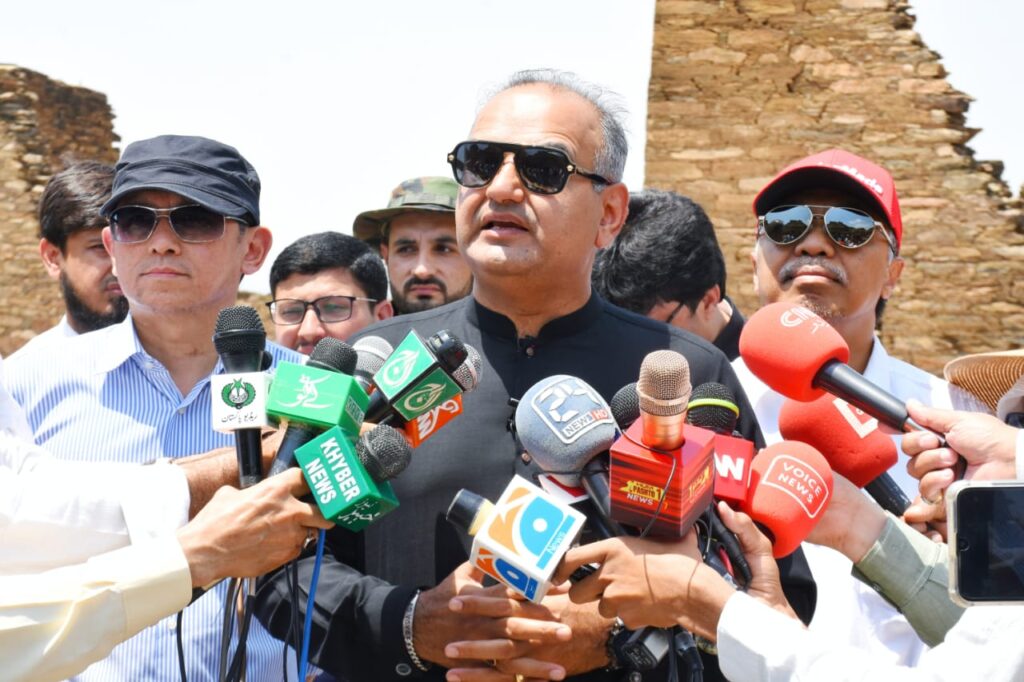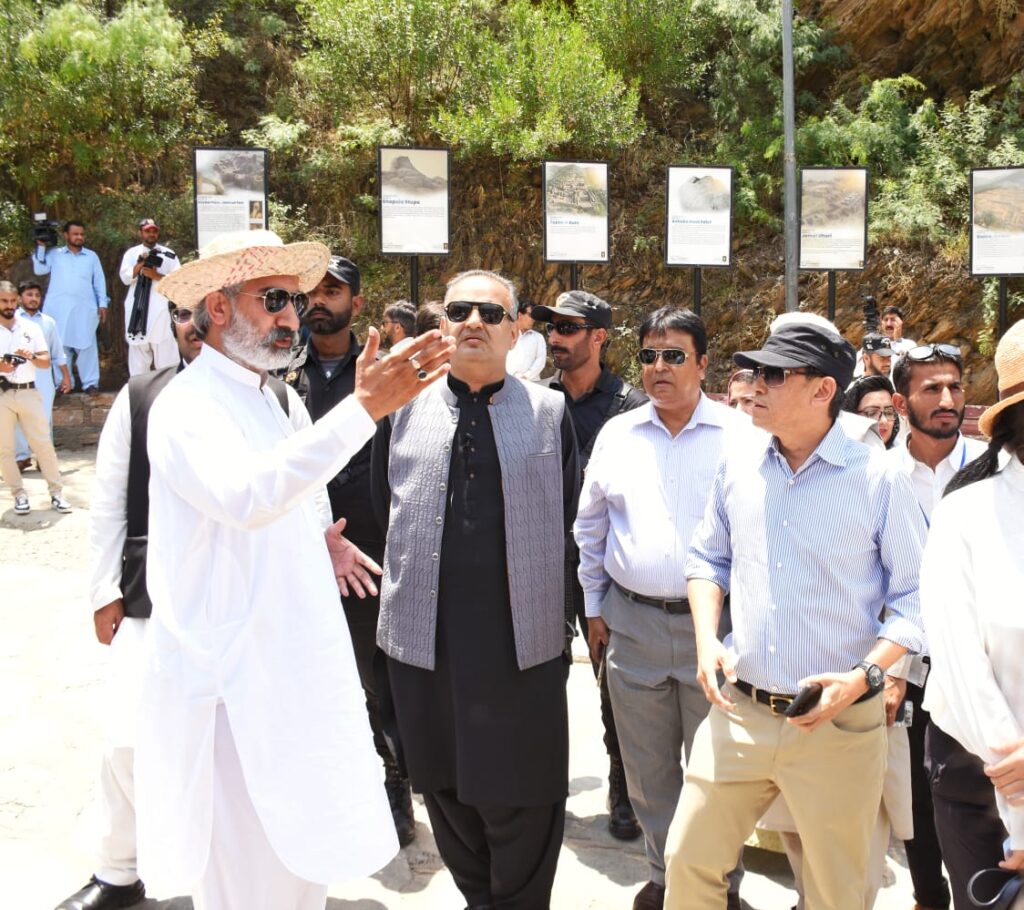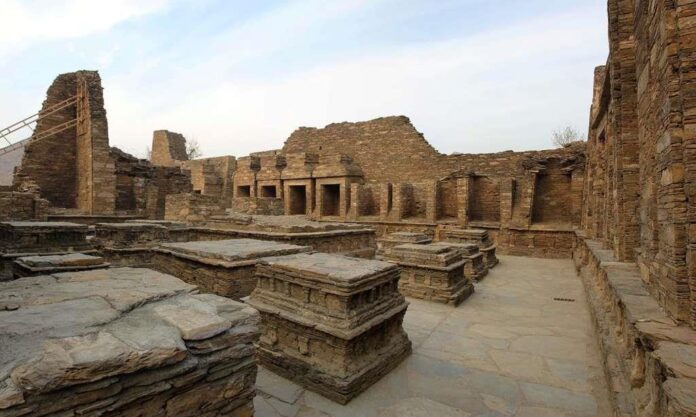KP govt & archeology dept making efforts to promote tourism at sites of historic importance
 By Naveed Ahmed Khan
By Naveed Ahmed Khan
A delegation of diplomats Ambassador of Thailand to Pakistan Chakkrid Krachaiwong, Ambassador of the Republic of Indonesia to Pakistan, Adam Mulawarman Tugio along with other foreign guests from China and Nepalese visited the Takht Bhai archaeological site with their families. The minister of state and chairman of Prime Minister Task Force on Gandhara Tourism, Dr. Ramesh Kumar Vankwani, led the delegation. The members of the delegation were also accompanied by relevant Pakistani officials.
Talking to media, Dr. Ramesh Kumar said that government taking measures to promote archaeological tourism as it would present a positive image of Pakistan around the world. He said Gandhara relics in Khyber Pakhtunkhwa were 2,000-years old and most of the Buddhist sites were in different parts of Khyber Pakhtunkhwa (KPK). He added that Gandhara civilization and Takht Bhai sites were included in the UNESCO heritage in 1980. During the 5th and 6th century, when the Huns of Central Asia were expanding their empire across modern day Pakistan and Afghanistan, Buddhist sites were destroyed by the hundreds. Some monasteries and temples escaped the brunt of the attack, thanks to their relatively inaccessible locations.
 Takht Bhai located in KPK city Mardan, one of the last surviving ancient Buddhist sites in the region; it escaped the brunt of several Hun invasions due to its remote location. One of these was the Takht-i-Bahi monastery, an important Buddhist site even today. Takht, in Persian means throne, and bahi means spring, and this throne of springs is situated in the higher reaches of the Mardan city of KPK province in Pakistan. Though it sustained some damage, it is among the most well-preserved early Buddhist sites in the region.It was built as a small stone monastery in the 1st century, and one of the earliest inscriptions found refers to Gondophares, the Indo-Parthian king of the time. Under the patronage of the rulers of different dynasties who followed, more structures were added to the original premises. Over the next 800 years, it developed into a large Buddhist complex, one of the most influential in the region, and it was supported by the nearby fortified town of Sahr-i-Bahlol. The town’s residents regularly carried offerings and food for the monks who lived at Takht-i-Bahi.
Takht Bhai located in KPK city Mardan, one of the last surviving ancient Buddhist sites in the region; it escaped the brunt of several Hun invasions due to its remote location. One of these was the Takht-i-Bahi monastery, an important Buddhist site even today. Takht, in Persian means throne, and bahi means spring, and this throne of springs is situated in the higher reaches of the Mardan city of KPK province in Pakistan. Though it sustained some damage, it is among the most well-preserved early Buddhist sites in the region.It was built as a small stone monastery in the 1st century, and one of the earliest inscriptions found refers to Gondophares, the Indo-Parthian king of the time. Under the patronage of the rulers of different dynasties who followed, more structures were added to the original premises. Over the next 800 years, it developed into a large Buddhist complex, one of the most influential in the region, and it was supported by the nearby fortified town of Sahr-i-Bahlol. The town’s residents regularly carried offerings and food for the monks who lived at Takht-i-Bahi.
 Despite surviving the invasions that wreaked havoc around it, the monastery saw a slow decline in the 7th century, when influence of Buddhism was on the wane, and donations to the monastery were dwindling. The monastery was abandoned by the monks, and it was only rediscovered in the second half of the 19th century. Excavations were carried out from 1907 and hundreds of statues and sculptures were unearthed. The complex today comprises of the main court of stupas, cells where the monks meditated, meeting halls, and covered passages. Its artifacts and buildings helped shed more light on early Buddhist history as well as Pakistan’s past. It, along with the nearby ruins of Sahr-i-Bahlol, was declared a World Heritage site by UNESCO, in 1980.
Despite surviving the invasions that wreaked havoc around it, the monastery saw a slow decline in the 7th century, when influence of Buddhism was on the wane, and donations to the monastery were dwindling. The monastery was abandoned by the monks, and it was only rediscovered in the second half of the 19th century. Excavations were carried out from 1907 and hundreds of statues and sculptures were unearthed. The complex today comprises of the main court of stupas, cells where the monks meditated, meeting halls, and covered passages. Its artifacts and buildings helped shed more light on early Buddhist history as well as Pakistan’s past. It, along with the nearby ruins of Sahr-i-Bahlol, was declared a World Heritage site by UNESCO, in 1980.
The Ambassador of the Republic of Indonesia to Pakistan, Adam Mulawarman Tugio said that Pakistan is a beautiful country, Takht Bhai was of great importance not only for Pakistan but for the whole world. He also appreciated the steps taken by the government to preserve archeological sites and promote tourism. The Indonesian Ambassador said that “I hope his visit will set in momentum visits by Buddhist tourists from across the world to Pakistan and to these rare, historic sites”. According to him Buddhists are 600 million in population and each year they visit various parts of the world to see Buddhist sites which are abundant in Pakistan. “We only need to provide these tourists with enabling environment so that they could come to Taxila, Peshawar, Takht Bhai, Swat Valley and other sites rich with Buddhist marks, said Ambassador.
Thai Ambassador termed the site as a masterpiece of historical architecture and expressed hope that they would facilitate their nationals to visit Pakistan’s archeological sites in their respective countries and increase tourism links. According to the delegation, Pakistan is an important country for minorities. The Buddhist site at Takht-i-Bahi is one of the oldest monasteries in the world, with both Takht-i-Bahi and Swat being close to each other and both famous for their Buddhist sites, attracting the attention of local and foreign tourists alike. It was part of the Gandhara civilization, one of the earliest urban settlements in the history of the subcontinent.



